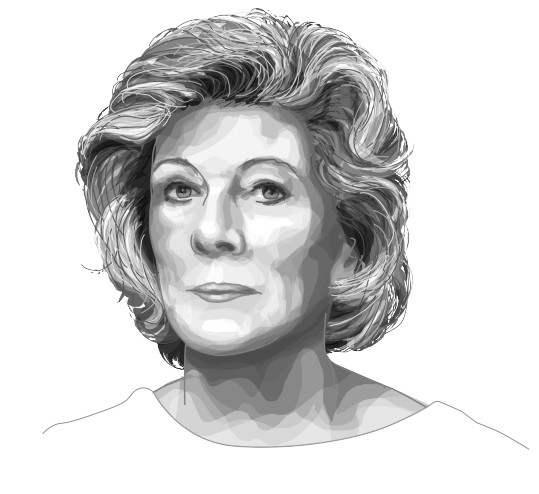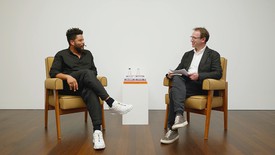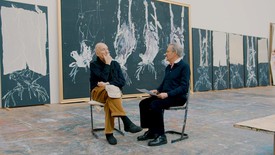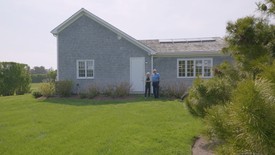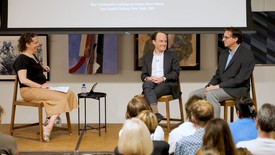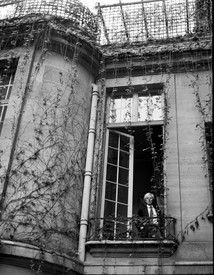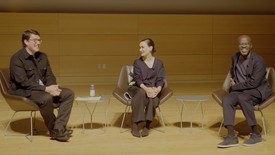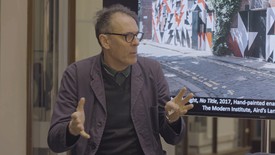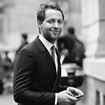
Derek Blasberg is a writer, fashion editor, and New York Times best-selling author. He has been with Gagosian since 2014, and is currently the executive editor of Gagosian Quarterly.
Derek Blasberg The first time I met you at a dinner party, you made the declaration: “Art is a right, not a privilege.” Do you remember saying that?
Agnes Gund Yes, probably. To be honest, I’ve said that many times, so I can’t remember every time I’ve said it.
DB What lead you to that conclusion? What were your developmental art memories?
AG I grew up in Cleveland, Ohio, one of six children born within seven years. So, something had to be done with us. We went to art classes in the morning at the Cleveland Art Museum, and then we’d be sent to riding school in the afternoons. I loved the Cleveland Museum; in fact I memorized just about everything in it. I went to high school at Miss Porter’s School in Connecticut, and I had a wonderful teacher called Sarah B. MacLennan, who had a PhD in art history. She would send me postcards from the Frick, the Isabella Stewart Gardner Museum, The Phillips Collection, and the Morgan Library. She really inspired my appreciation for art. On the weekends, I’d come into New York with an aunt, and we would go to all the museums in the city. We would go to the Museum of Modern Art and to the Metropolitan Museum of Art. I went to the Frick Collection so many times that I knew where everything was by memory. I sometimes joke that if I ever go to prison, what’s going to keep me from going crazy is that I have these museums memorized, and I can go through them and see all my favorite things in my head.
DB I take it art was a big part of your education then.
AG It was just a big part of my life. Even at home, we had been surrounded by art. My father was a collector of various things, but he especially liked American Western artists, including Remington, Russell, Catlin, and Schreyvogel. Every wall was covered. At private school, we had art classes, and even though I was a terrible artist, I always appreciated that part of the educational process.
DBWhat do you mean you were a terrible artist?
AGOh, I was pretty awful. My dogs would always look like a horse, and my horses would always look like a dog. But that’s what I like about art. There’s no right and wrong in art.
My dogs would always look like a horse, and my horses would always look like a dog. But that’s what I like about art. There’s no right and wrong in art.
Agnes Gund
DBThat sounds like a valuable lesson to learn, which brings us to Studio in a School, the organization you started to continue arts education in inner-city schools. When was that founded, and why?
AGIn 1976, I was living in Greenwich, Connecticut, because my husband at the time was the head of Greenwich Country Day School. One day, I read in the paper that all the arts had been cut from elementary schools, which I thought was just ridiculous. So I called my friend, Patricia Hewitt, who had worked with nonprofits before, and decided right then to begin Studio in a School, an organization that promoted both arts and arts education in public schools. That was thirty-eight years ago. The first year we started with three schools—two in the Bronx, one in Manhattan. And then we had five the next year. Now, it’s in one hundred fifty schools.
DBWhy do you think you had such a big reaction to this? Had you felt passionate about arts in education before this?
AGI think I was most taken by the fact that not having art in schools didn’t give a chance to kids who needed another way of expressing themselves. We organized parent-student workshops so that parents could see what art was like, and the joy it can bring to kids. We sent home packets for parents to develop art education at home, so they could see how interested the kids can be in art and self-expression. You and I know this, this is available to us, but not every family buys arts materials as birthday and Christmas presents.
DB When I was kid, art was my favorite class.
AG Exactly, and there are those students who may only have the confidence to speak up in an art class, who will only feel like they belong in an art class. Maybe they’re not good at math or they have a hard time with history. Where is the place in school that these kids will find their confidence if there is no arts program?
DBIn some neighborhoods, I imagine a career in the arts might seem like a foreign idea.
AGThat’s why we wanted artists to come in and meet the classes; that’s why we helped some of these kids get jobs in art museums. We’ve had some wonderful artists come: Jeff Koons, Ursula von Rydingsvard, William Wegman, Wendy Mark, Claudia DeMonte, Fred Wilson. I can remember the kids would ask, “You can really make a living as an artist?” It was astounding for them. They didn’t realize that this could be a profession. We want children to know that they can have a job in the arts.
DBWhen did you start collecting more seriously?
AGWhen I got married after college, in 1963, I began to be interested in collecting art, in owning it, though I started with very small pieces. My father passed away in 1966, and that’s when I started collecting things that were, at the time, fairly expensive. I was asked to be a member of the International Council of the Museum of Modern Art in ’67, and then in ’68, I became a member of the Painting and Sculpture Committee.
On the weekends, I’d come into New York with an aunt, and we would go to all the museums in the city. We would go to the Museum of Modern Art and to the Metropolitan Museum of Art. I went to the Frick Collection so many times that I knew where everything was by memory.
Agnes Gund
DBWhat are you looking for when you’re shopping for art?
AGEverything. That’s my problem. I can’t go look at galleries without ending up wanting to have something. It’s a disease. Now I avoid things. I don’t go to Art Basel in Switzerland because I know I’ll come back with something. Sometimes I go to Miami, though.
DBWhat are you drawn to?
AGI’m drawn to things that make me want to see them over and over. [Pointing to the artwork above her desk] I wasn’t familiar with the artist of this piece, Poul Gernes, but I went into a gallery show downtown, and I just loved it. I’m still attracted to the works of artists that I have collected or known for years, like Jasper Johns, Ellsworth Kelly, Roy Lichtenstein. And I focus on buying from female artists and African-American artists now.
DBThat’s a lovely way of summing up a collector’s ethos: “I buy things I want to see more than once.”
AGOh, but it’s true. Many times, I think someone will buy something solely because they think it’s a good investment. Terrible idea. Every time I’ve bought a work of art for any reason other than I love it instinctively, well that has been a mistake. I found that they didn’t hold up with me. I would go into the room, and I wouldn’t look at it, I wouldn’t be curious about it, I wouldn’t try and figure it out. So, I’d sell it.
DBDo you rotate the art in your house?
AGWe loan quite a bit. I’d like to switch things out more often, but it can be a hassle for large works. My storage unit is not close, and putting a crane on Park Avenue is a nuisance. What I love to do is studio visits, and I do those often with some of the people on the PS1 Board. I love seeing studios with that board, people like Klaus Biesenbach, Diana Widmaier Picasso, Adam Kimmel, Dana Farouki, Jennifer McSweeney. They’re young, they’re interested in art, and they introduce new people to me. Adam was the first person to take me to Joe Bradley’s studio. I loved it, and I bought something for myself.
I’d really like to see more women get into politics, because I think women have a different way of doing things, and it’s a good thing to balance the men.
Agnes Gund
DBYour contributions to MoMA have been impressive.
AGI love to buy things for the museum, but I should say it’s especially gratifying when they don’t come to me to buy them. I come to them and say, “Wouldn’t you like this? Or, is this artist on your radar yet?”
DBDo you think that’s an important part of the museum world, to look at young artists?
AGThat’s why I like to be on these committees. Like the Media and Performance Committee at the Museum. I don’t collect media often, maybe I have three or four things. My ex-husband didn’t like the noise of the pieces. But I’ve enjoyed meeting so many of these new artists. PS1 is a treat for me.
DBHave your children followed in your footsteps into the art world? What do they do?
AGMy daughter, Catherine, is a documentary filmmaker. Her recent film, Born to Fly, about the American contemporary dancer and choreographer Elizabeth Streb, was just released last month and is making its way around the country. Several of my grandchildren are also involved with the arts. Just to name a few: Sadie is majoring in photography at Brown University; Max is enrolled in an art college in San Francisco; Giaco has performed in several TriArts Sharon Playhouse productions; and Tenzin is a member of the Young People’s Chorus of New York City.
DBLook at that, still a proud grandmother.
AGMy siblings are also very much involved with the arts: Gordon is an artist and art collector; Graham is a renowned architect and art collector; Louise is a theater producer (she just won a Tony Award for All the Way) and has an excellent collection of Tibetan art.
DBI’m buddies with some of the people on the PS1 committee, and I asked them about you before our chat today. Three words kept coming up when we’d speak about you: Democrat, feminist, and dog lover. What do you think about that?
AGHa. Well, I am, sometimes unfortunately, a very big giver to Democratic causes. And women? Yes, I’d like to think I’ve been supportive of feminist causes in my life too. For example, tonight I’m doing a cocktail party for Wendy Davis.
DBThe Texan politician who filibustered the abortion law in the pink suit and tennis shoes?
AGYes, that’s the one. Now she’s running for governor in Texas. I’d really like to see more women get into politics, because I think women have a different way of doing things, and it’s a good thing to balance the men.
DBAnd what about “dog lover”?
AGI do love my dogs. I have two, and they both have names inspired by artists: Giotto and Bronzino. Everyone thinks I’ve named Bronzino after the fish, but his name is Bronzino, after the late-Renaissance artist, not branzino, the seafood entrée.
DBThis confusion could enforce the idea that we need more arts education in our schools.
AGI think you’re absolutely right.
